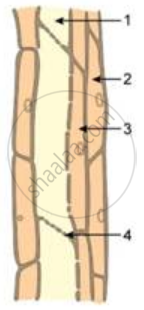Advertisements
Advertisements
Question
What do you know about complex tissue? Classify and explain its different types in plants with suitable diagrams.
Solution
Complex tissues:
The complex tissues consist of more than one type of cells having a common origin. These tissues are involved in transporting water, mineral salts (nutrients), and food materials to various parts of plant.
The complex tissues are of following two types:
1. Xylem:
It is a conducting tissue composed of cells of four different types—that is, tracheids, vessels, xylem parenchyma, and xylem fibre.Except xylem parenchyma, all other xylem components are dead and lignified. Tracheids and vessels are involved in the conduction of water. Xylem parenchyma stores food and helps in lateral conduction of water.

2. Phloem:
It is also a conducting tissue and consists of four elements—that is, sieve tubes, companion cells, phloem parenchyma, and phloem fibres.Except phloem fibres, all phloem elements are living. Sieve tubes and companion cells work as a single unit. Phloem transports (conducts) photosynthetically prepared food materials from the leaves to the storage organs and later from storage organs to the growing regions of the plant body.

APPEARS IN
RELATED QUESTIONS
What are simple tissues? Explain their three different types.
Draw a well labelled diagram of parenchyma and collenchyma.
Write a short note on sclerenchyma.
Distinguish between xylem and phloem.
What is simple tissue? Classify and explain its different types with suitable diagram.
What is simple tissue? Classify and explain its different types with suitable diagram.
Study the diagram given below and then answer the question that follows:

State the function of the parts labelled 1, 2, 3 and 4.
The question has four answers. Choose the correct answer:
The parenchymatous tissue is
Distinguish Between Internal or anatomical difference between monocots and dicots.
Cells of this tissue are living and show angular wall thickening. They also provide mechanical support. The tissue is ______.
